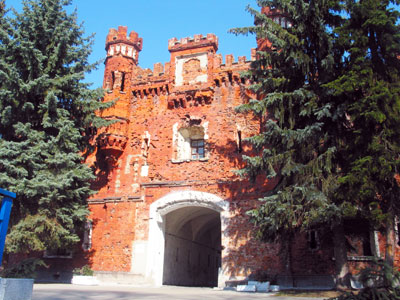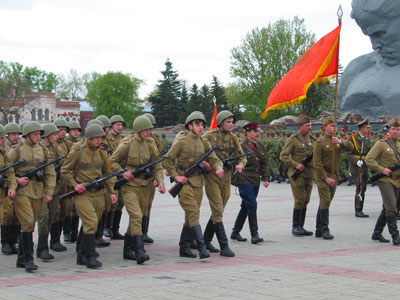Настройки шрифта
Arial
Times New Roman
Межбуквенное расстояние
Стандартное
Увеличенное
Большое
Цветовая схема
Черным
по белому
по белому
Белым
по черному
по черному
Brest Fortress



The people highly appreciated the feat of the defenders of Brest fortress. By decree of the Presidium of the Supreme Soviet of the USSR of 8 May 1965 Brest fortress was awarded the honorary title "Fortress-hero" with the presentation of the Lenin order and the medal "Gold Star", which were placed on perpetual deposit in the museum of the memorial complex.
By enactment of the Council of Ministers of the BSSR a creative group was founded in 1967 with the purpose of developing the project of a monument. It was headed by sculptor Aleksandr Pavlovich Kibalnikov, a laureate of the Lenin and State Prizes of the USSR, a popular painter of the USSR. The creative group included: V. Korol, a popular architect of the USSR; sculptor A. Bembel, a popular painter of the BSSR; V. Zankovich, a laureate of the Lenin Prize; architect O. Stakhovich, a laureate of the State Prize; architect G. Sysoyev, a laureate of the State Prize of the BSSR; sculptor V. Bobyl; architects V. Volchek and Yu. Kazakov.
25 building and construction organisations sent their best specialists to erect the memorial. The collectives of Brest enterprises, organisations and educational institutions participated actively in the construction of the memorial complex.
A mourning meeting took place in the fortress on 18 September 1971. The mortal remains discovered during the construction in the territory of the memorial, as well as those of the fortress defenders who had been interred in the garrison cemetery before were buried with great respect under memorial gravestones.
The inauguration of the memorial complex "Brest fortress-hero" was held on 25 September 1971. One of the honourable visitors was writer Sergey Sergeyevich Smirnov, who had dedicated more than 10 years of his life to the search of fortress defenders. He had restored for history the names of the dead heroes, and become a support and close friend of the survivors. For the book "Brest fortress", which raised several generations of readers, S.S. Smirnov was awarded the Lenin prize.
The integrated architectural and artistic complex, which immortalised the legendary but true story of the heroes of Brest fortress, represents ruins of the old fortress, battle spots, and monumental sculptural compositions.
The Main entrance has become an original overture to the sculptural poem. A five-point star, a symbol of military valour and honour, looks as if it is carved in a reinforced-concrete block. Sounds of the metronome counting down the last peaceful moments are heard under the vaults of the Main entrance. Then one can hear the increasing roar of the approaching bombers; the deafening howling and thunder of exploding bombs and shells; the song "The Sacred War" by A. Aleksandrov is played; announcer Yu. Levitan reads the text of the governmental message on occasion of the treacherous aggression of the troops of fascist Germany against the Soviet Union.
The central alley leads to the Citadel. The sculptural composition "Thirst" symbolising thirst for life, struggle and victory is erected to the left of the bridge on the bank of the Mukhavets River. Ceremonial Square begins from the ruins of the White Palace. The 100-m titanium-coated bayonet obelisk, a symbol of military bravery, can be seen from afar. The Main monument 31.5 m in height and 50 m in width, made of reinforced concrete, towers over the ruins of the former Engineering board. In the severe stare of a warrior, who looks as if he is stepping forth from an unfolded banner, one can see sorrow at his dead comrades, enormous will-power, courage and inflexible resolution to stand to the bitter end. On the backside of the monument one can find bas-reliefs representing the most important episodes of the fortress defence.
Three tiers of granite gravestones are situated in the centre of the architectural complex. The remains of 962 people who died in the fortress lie under them. The names of 269 fortress defenders and members of their families are written on the gravestones. The others are mentioned as "unknown".
Eternal flame is burning in front of the ruins of the former Engineering board in a cavity coated with black labradorite. The moderate and majestic melody "Daydreams" by Schumann imparts special emphasis to the words inscribed at the fire: "They have stood to the death. Praise the heroes!" Piotr Mironovich Masherov, First secretary of the Central Committee of the Communist party of Byelorussia, a Hero of the Soviet Union, lit the eternal flame on the day of the inauguration. A memorial area of the cities-heroes was laid near the eternal flame on 9 May 1985.
Not only the music and sound accompaniment has an influence upon the visitors, but also the evening artistic and decorative illumination of the memorial. The footpaths and the square in front of the Main entrance are coated with red asphalt. The territory of the memorial is planted around with roses, weeping willows, thujas, and silver fir-trees.
During the years of the museum and the memorial the fortress on the Bug has become a centre of military and patriotic upbringing. Many good traditions have formed there. Memorial groups from schools and vocational schools of the city keep honourable watch on the Memory Post. Every year on the Victory Day of 9 May people gather to pay the tribute to the dead and living participants of the Great Patriotic War. Young soldiers of Brest garrison swear on the sacred ground of the fortress. Newly wedded couples bring flowers to the fortress on the wedding day. On 1 September students are presented with student cards in Ceremonial Square.
St. Nicholas’ church, which was handed to Brest/Kobrin eparchy in 1994, is situated in the territory of the fortress. Since September 1995 Orthodox believers have been coming to find spiritual satisfaction there. Requiem liturgies are chanted yearly on 22 June to honour those who died in that territory. Works on the general overhaul and restoration of the memorial complex and the temple are going on.
People of all ages, convictions and trades come to the fortress, and few of them remain indifferent, and few of them are not shocked at what they can see or hear there. In opening pages of the history of the Great Patriotic war for the young generation, Brest fortress and its defenders have tenderly kept the memory of the past during all those years and helped treat the present with wisdom and responsibility.